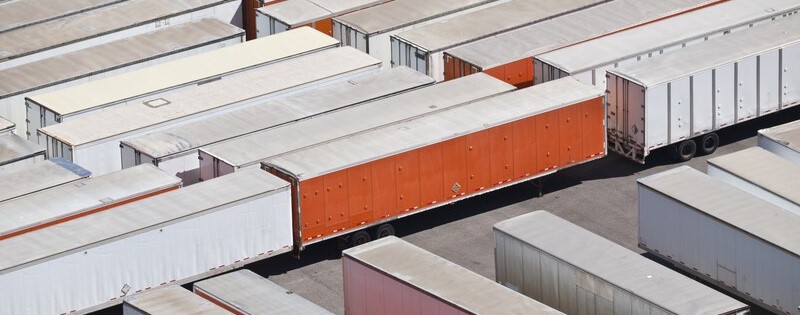Industrial outdoor storage (IOS) is emerging as an increasingly popular property sector among institutional and other types of investors.
Interest in the sector ramped up during the pandemic as space was needed for container storage to relieve backlogged ports. Estimates from the experts WMRE interviewed suggest that the U.S. IOS market, which represents a niche within the larger industrial asset class, ranges somewhere between $130 billion and $200 billion in value.
Zoned for industrial use, IOS sites typically house vehicles, construction equipment, building materials and even shipping containers on an interim basis and range in size from two to 10 acres, often including a small building. The sector has been referred to as a “beautiful ugly duckling” by Green Street’s Vince Tibone since the properties are just lots with storage containers and construction equipment that have delivered “exceptional” returns over the last three years and brought in more institutional investors for funds raising hundreds of millions of dollars to target IOS.
While the sector is not immune to the same forces that are affecting other property types in the current environment, Tibone said he remains bullish on IOS over the next five to 10 years. Investor demand for IOS has been buoyed by strong recent operating results, favorable long-term supply/demand dynamics and a minimal cap-ex burden with an option to use the land for a higher and better use at some future time.
IOS sites located in infill submarkets in particular can deliver risk-adjusted returns “that are superior to those available on most other commercial real estate investments, including traditional industrial,” Tibone said. However, the fragmented, non-institutional ownership structure of the sector today makes it difficult to invest at scale, he noted.
“IOS portfolios do not come on the market often and the best returns are likely available through one-off deals, where there could be operational upside left on the table from the prior owner,” Tibone said. “Those with the patience and wherewithal to aggregate infill IOS sites over time should be rewarded with robust total returns relative to other property types.”
Among investors that are currently raising funds and targeting acquisitions in the IOS marketplace is EverWest Real Estate Investors, a Denver-headquartered real estate investment advisor with $5.2 billion in assets under management, including in the industrial, multifamily, office and retail sectors.
EverWest operates open-end funds and three single–client accounts with industrial strategies focused on IOS. The average size of the deals it has completed ranges between $10 million and $25 million.
So far in 2023, EverWest acquired two IOS sites—39.6 acres south of Atlanta for $12 million and 4.12 acres in Miami for $12.5 million, according to John Maurer, EverWest’s senior managing director and head of portfolio management. In May, the firm also invested in an industrial asset in Carlson, Calif. that includes acreage that can be used for IOS.
Part of the appeal of the sector is that when U.S. industrial inventory tightens and rents rise, IOS sites rise in value as they become reliever locations for a wide range of logistics activity, Maurer noted. In addition, in a market where industrial assets are still often priced at a premium, with cap rates as low as 4.5%, an IOS site adjacent to such a traditional industrial asset will often sell at a cap rate that’s 50 basis points higher. Rental rates in the sector have also been rising by 3.5% to 4.0% a year, according to Maurer.
EverWest’s open-end fund, the Open End Diversified Core Equity Fund in the NFI-ODCE Index, has a target return of 10%. Like Tibone, Maurer noted that the IOS marketplace is less institutionalized than regular industrial and has more fragmented ownership.
“We think because it’s difficult to acquire these sites that are smaller, if you aggregate portfolios in a target market that there’s going to be a cap rate compression,” Maurer said.
As a result, EverWest aims to aggregate a number of acquisitions from different sellers to build up its IOS holdings. Over the past 12 to 18 months, the firm has invested about $200 million in the IOS sector and it hopes to double that volume in the next 12 to 18 months. EverWest is also planning to launch an enhanced fund with a higher return strategy in the near future that will have a significant IOS component, according to Maurer. The firm is hoping to build off its current investor base of public and private pension plans, foundations and endowments, insurance companies and financial advisors for the fund, Maurer said.
However, Maurer admitted that EverWest’s transaction volume is currently about 15% off what it was a year ago because the increase in interest rates has made the firm more selective in making new purchases.
“There are some compelling opportunities in the marketplace in terms of attractive return potential, given where rates are today versus they were 12 months ago,” Maurer said. “We always want to look at where pricing is going and take advantage of correctly priced opportunities. What we see is sellers ultimately capitulate and need liquidity, so they will sell at market-clearing prices based on our new model for interest rates in the current environment.”
Assuming a leverage level of 40% to 40%, EverWest’s investments can deliver gross returns of 12% to 14% over a seven- to 10-year period, Maurer noted. That would require a barbell approach of doing straight up five-year lease IOS deals, he said. There would also need to be some value-add component for redevelopment in its strategy. About 20% of the IOS marketplace is about adding a warehouse over time, Maurer noted.
Change Is Coming
In the meantime, the number of institutional players involved in the sector is growing. For example, Brooklyn-based Zenith IOS, a builder and owner of outdoor storage properties, has partnered with institutional investors advised by J.P. Morgan Global Alternatives, to buy hundreds of millions of dollars of IOS properties last year. In February, J.P. Morgan and Zenith IOS announced a $700 million joint venture to buy more IOS assets.
Another active participant in the marketplace is Alterra IOS, which is part of Philadelphia-based Alterra Property Group, a real estate investment and development company that, according to reports, made more than $850 million in acquisitions over the past year.
In its most recent announcement, dated June 22nd, the firm expanded its presence in Las Vegas by acquiring a six-acre site for $7 million—its third in the marketplace.
Alterra declined to comment on its current fundraising effort, instead referring to a public filing from the Ventura County Employees’ Retirement Association (VCERA). The filing contained a recommendation to commit $35 million from the pension fund to Alterra’s IOS Venture III fund. Alterra’s goal has been to raise $750 million for the fund targeting IOS properties, according to IPE Real Assets. A previous Alterra fund raised $524 million in 2022, exceeding the firm’s goal of $400 million.
IOS Venture III will target smaller, infill IOS assets operating on triple net leases. Part of the value proposition of these assets, according to VCERA’s filing, is that they are typically owned by single owner-operators and have escaped the attention of most institutional investors. Alterra also plans to leverage its in-house management and leasing expertise to pursue value-add strategies for the assets. The firm estimates that it will generate from 30% to 40% of its total returns through the assets’ current cash flow, creating annual cash flow yields of 6% to 8%.
The fund has an eight-year horizon, with two one-year extension options, and will offer a preferred return to investors of 9%, with a carried interest of 20%. The fund’s net IRR target is between 14% and 16%, with a leverage ratio of 65%.
In addition to VCERA, Alterra’s equity investors include other public pension funds, foundations, endowments, insurance companies and family offices, both domestic and foreign, according to Managing Director Matthew Pfeiffer.
“Investors are finding IOS an attractive proposition right now because, unlike with a number of other real estate assets, supply is structurally muted, with municipalities not being incentivized to add new zoned land for outdoor storage,” Pfeiffer said.
He also mentioned the attraction of low cap-ex.
“Beyond the favorable supply and demand dynamics, IOS also benefits from being a very low capital expenditure business translating into low frictional leasing costs to put new tenants in the space,” Pfeiffer noted. “Lastly, the tenant profile is largely credit and national, under a triple-net lease structure that further entices institutional capital’s interest in the space,”
According to BJ Feller, managing director and senior vice president at Northmarq, cap rates on traditional industrial properties have gotten so aggressive in recent years that institutional capital was looking for opportunities with a similar profile, but more attractive cap rates.
“Once they’ve been able to establish their credibility and track record in the segment, we’ve seen operators have great access to the capital sources who want to play in this asset class,” Feller said.
He added that while equity inflows to the sector have “cooled to a certain degree” on a year-over-year basis, they remain robust relative to other property types.
“Most of the decline has been a reaction to caution that cap rates may be going mildly higher and offer better acquisition opportunities in the months ahead,” Fuller said.
Source: Wealth Management


